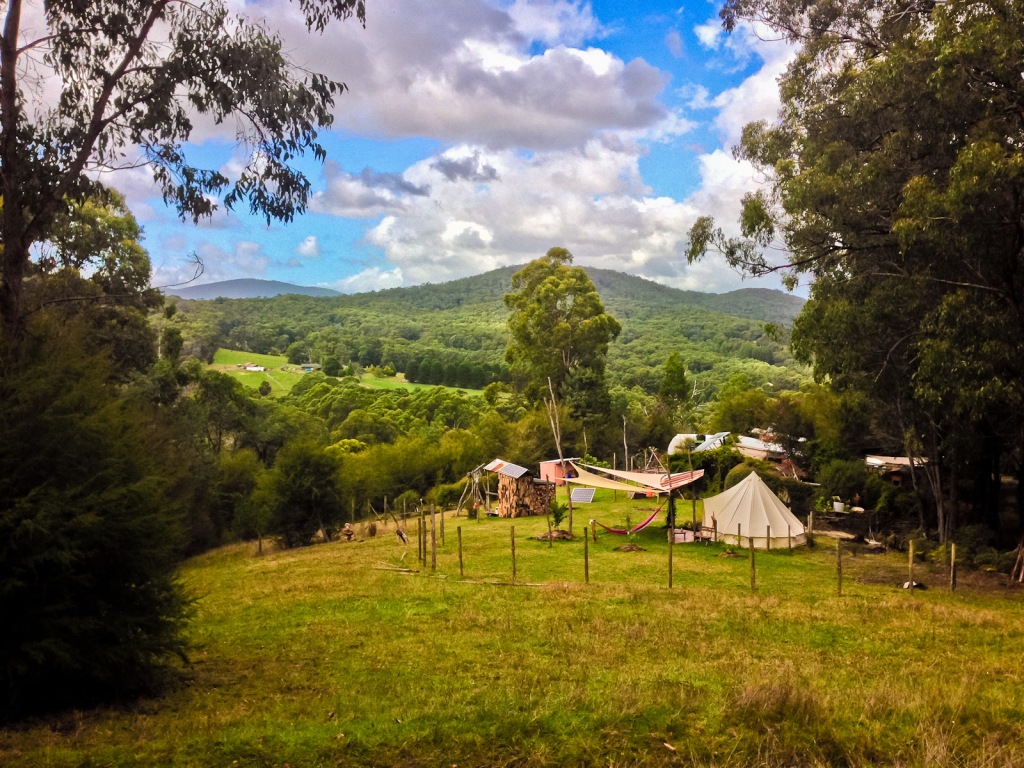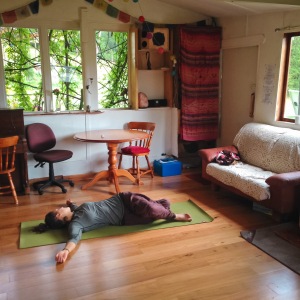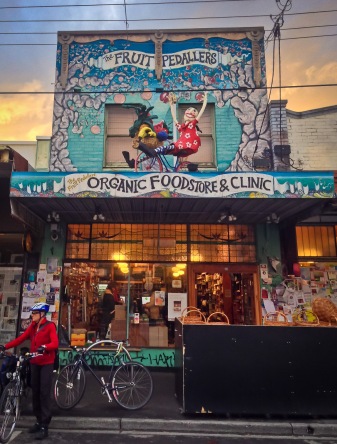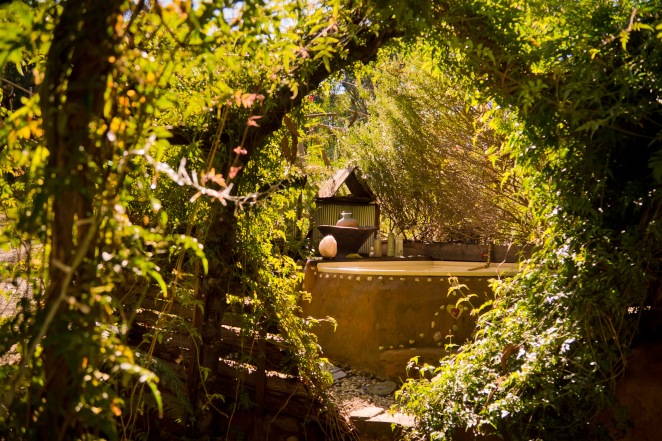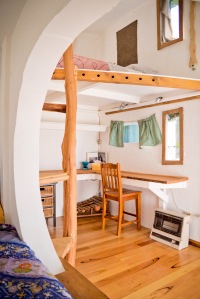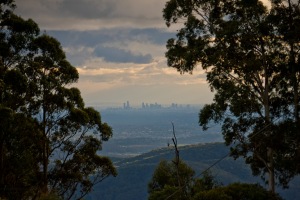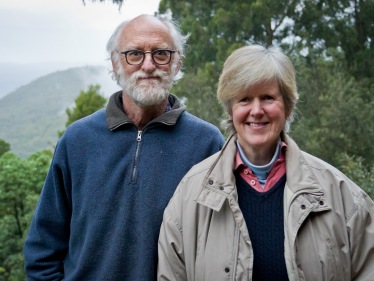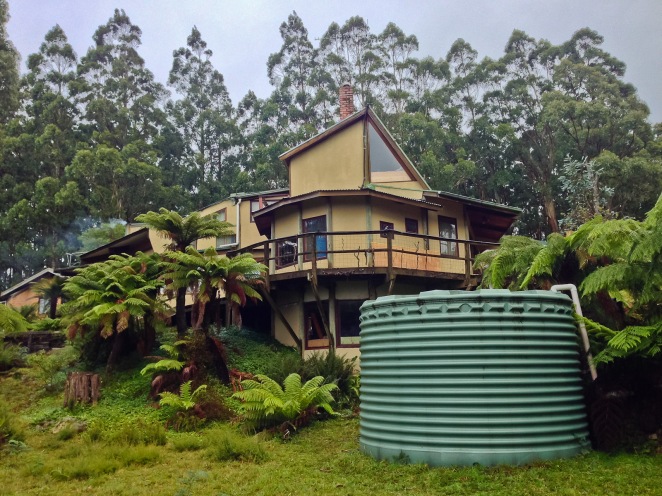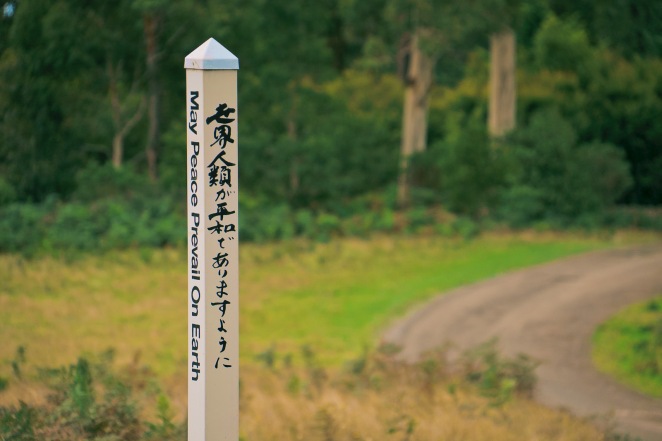~ DESTINATION THREE: BUNDAGEN, NSW ~
Proof that hippie communities can evolve beyond simple ideological experiments
Back at our campsite that shares the same beach as Bundagen’s intentional community, I can continue to enjoy the natural haven that is this part of the New South Wales coastline.  About 20 minutes drive south of Coffs Harbour and close to the eclectic town of Bellingen which is back-dropped by a stunning Dorrigo National Park, this sub-tropical zone is our first real taste of the more northerly climes of Australia – wetter, more humid, more lush. It is an excellent climate for organic farming, straddling Mediterranean and tropical, and features lush rainforest, picturesque mountains, achingly-beautiful surf beaches and small, inviting towns. Heidi and I felt a lot of external loves and soul-filling elements clicking together here right off the bat.
About 20 minutes drive south of Coffs Harbour and close to the eclectic town of Bellingen which is back-dropped by a stunning Dorrigo National Park, this sub-tropical zone is our first real taste of the more northerly climes of Australia – wetter, more humid, more lush. It is an excellent climate for organic farming, straddling Mediterranean and tropical, and features lush rainforest, picturesque mountains, achingly-beautiful surf beaches and small, inviting towns. Heidi and I felt a lot of external loves and soul-filling elements clicking together here right off the bat.
For 35 years, Bundagen Cooperative has been an off-grid settlement to a group of folks looking to connect more with nature and other like-minded souls in a beautiful part of Australia. Over 110 people – spanning three generations – live and work here, growing organic veggies, meditating, playing and experiencing life mostly off the mainstream treadmill. Theirs is not a utopia, but rather what they aptly describe as “a microcosm of the macrocosm, with all the dramas of the wider world played out on our small stage.” One person we met said that it was originally a ‘social experiment’ to experience the limitations of such a community.
 This community began in an appropriately activist manner: in the late 70’s, happy hippie folk used the farm land for environmentally joyful pursuits and were friendly with the local farmer who owned it. In 1981, the property came available for sale and Japanese interests swooped in with designs on redeveloping the land into a resort and golf course. The farmer sided with the concerned hippies and chose to sell the land to them which the group managed to do via their “alternative networks”. Hooray! This wily rogue of determined environmentalists defeated the big developers and have since cared very well for the land, even
This community began in an appropriately activist manner: in the late 70’s, happy hippie folk used the farm land for environmentally joyful pursuits and were friendly with the local farmer who owned it. In 1981, the property came available for sale and Japanese interests swooped in with designs on redeveloping the land into a resort and golf course. The farmer sided with the concerned hippies and chose to sell the land to them which the group managed to do via their “alternative networks”. Hooray! This wily rogue of determined environmentalists defeated the big developers and have since cared very well for the land, even  having part of it deemed a protected national park (Bongil Bongil).
having part of it deemed a protected national park (Bongil Bongil).
We were originally drawn to this community as it sounded like a nice balance of alternative, sustainable, meditative/spiritual and mature. Having spent two weeks there as WWOOFers with our hosts Jo and Giri (pictured), I think that our initial hopes and assumptions were largely bang-on. From a visual perspective, Bundagen is a beautiful spot; we largely spent our time in one of 12 villages within the community – Bananas village (it was named as it was a former banana plantation, not because the people are crazy and wild like I first thought 😛 ) – and it is green, tropical and well-kept. Cars are “officially” limited in the village and the “roads” are greenways between houses (and one gorgeous path that takes you to an exquisite private stretch of beach).

Our hosts’ open-plan home, surrounded by lush rainforest
In our village, all of the homes are unique with many being hand-built creations using many types of natural materials, plus some caravans, old buses and other interesting structures thrown into the mix. There are no fences which seems obvious in a place that is supposed to promote community and openness, but experiencing it still feels very different than our mainstream suburbs where there are divisions all over the place: bitumen roads and footpaths, council-maintained areas, boundary fences and walls,  chain-link in public areas, speed and traffic signs and so on. In my opinion, this is still and has always been one of the defining factors of living in community: you live together, trust each other and provide safe, harmonious and attractive common spaces that generally don’t require division or external policing. Going back into these conformist settings once you’ve been in a community like this immediately makes me feel uncomfortable. Mainstream society is largely not natural.
chain-link in public areas, speed and traffic signs and so on. In my opinion, this is still and has always been one of the defining factors of living in community: you live together, trust each other and provide safe, harmonious and attractive common spaces that generally don’t require division or external policing. Going back into these conformist settings once you’ve been in a community like this immediately makes me feel uncomfortable. Mainstream society is largely not natural.
Other than visual appeal, the sustainable aspect is immediately obvious as well. The whole community is off-grid, so most villages have in-home composting toilets (plus a village shared loo), all water is rainwater harvested and electricity is solar. The off-grid stuff is done so well and effortlessly that you hardly notice it such that it is so well-integrated into the operation of the community. Until very recently, shared resources like a communal kitchen were still used, but an ageing population with a bit more saved income has resulted in more members building in-home conveniences and the village kitchen was torn down. There is, however, talk of building a new one, at least for a community hall to meet at. Other resources are still shared however, like tools and equipment, common machinery for maintaining roadways and lawns, and so on.
One of the biggest parts of this community (and of course the intent of all communities) is the relational part, and having spoken to numerous people about it, it seems that 95% of it is all good. Many of the folks we met had been there a long time and that in itself is indicative that members enjoy living there. It was fantastic to see so many healthy-looking 50 and 60-something folks, busy but smiling, and with tons of interesting wisdom to offer. However, of all the people we met, not one didn’t mention the challenges of conflict within a tight-knit community like Bundagen. In fact, not only do they mention their struggles with conflict resolution on their webpage, but we had numerous conversations about it, and witnessed it firsthand.
 Conflict resolution and internal politics are things that we have heard about in every community so it is clear to us that it a good system needs to be established early on. Members indicate that this didn’t really happen in Bundagen and this is their only real issue. Clearly they have made it work on some level to last this long, but the potential for fallout came into full illumination with a community member who was causing a rift between villages and individuals for many years. As good stewards of communal-living principles, the community-at-large have employed ongoing attempts at personal support over time, but sterner measures were being discussed. By all counts, this is unusual but it seems like something that has gone on far longer than is needed as the community didn’t have a comprehensive plan on to come down hard on frequent offenders. A further downside that we experienced was gossip, not just from this but from other things, which I suspect could cause other rifts if left unchecked.
Conflict resolution and internal politics are things that we have heard about in every community so it is clear to us that it a good system needs to be established early on. Members indicate that this didn’t really happen in Bundagen and this is their only real issue. Clearly they have made it work on some level to last this long, but the potential for fallout came into full illumination with a community member who was causing a rift between villages and individuals for many years. As good stewards of communal-living principles, the community-at-large have employed ongoing attempts at personal support over time, but sterner measures were being discussed. By all counts, this is unusual but it seems like something that has gone on far longer than is needed as the community didn’t have a comprehensive plan on to come down hard on frequent offenders. A further downside that we experienced was gossip, not just from this but from other things, which I suspect could cause other rifts if left unchecked.
Having come here on the heels of our Bruderhof experience was interesting; I am always hesitant to compare communities as they are apples and oranges, but being that they are so different makes it enticing to compare. The stand-out thing about a community like this is the organic nature of everything, which has its pluses and minuses.  On the plus side, Bundagen is lush, natural and beautiful with countless birds, monitor lizards, possums and bush turkeys in your garden (and the occasional python living in your rafters!); easygoing smiling folks from different walks of life doing creative and inspirational things with their diverse dwellings, clothing and interests; music/sing-along nights, working bees, clothing-optional bathing at the beach (apparently in the early days, even member meetings were in the nude!), wild organic gardens behind many homes, yoga/meditation sessions run by members; and a relaxed way of organising, administering and “being”. The downside, comparatively, might be what Bruderhof excelled at: structure and order, balanced education, blended multi-generational groups onsite, community unity (with gossip largely “outlawed”) and a central drive (Jesus) that affected every person; all this the kind of stuff that won’t happen without some forethought. Now, I know Bundagen residents would probably argue that some of those things are exactly what they don’t want, and I would personally choose a more organic lifestyle over a heavily constructed one, but there are levels of structure that Bundagen might consider virtues to employ, especially in light of their self-assessment on conflict resolution. And that’s not to say that Bundagen was lacking in a spiritual core; I think most people there felt some affinity with the Spirit, the land or both, they simply didn’t all subscribe to the exact same programme.
On the plus side, Bundagen is lush, natural and beautiful with countless birds, monitor lizards, possums and bush turkeys in your garden (and the occasional python living in your rafters!); easygoing smiling folks from different walks of life doing creative and inspirational things with their diverse dwellings, clothing and interests; music/sing-along nights, working bees, clothing-optional bathing at the beach (apparently in the early days, even member meetings were in the nude!), wild organic gardens behind many homes, yoga/meditation sessions run by members; and a relaxed way of organising, administering and “being”. The downside, comparatively, might be what Bruderhof excelled at: structure and order, balanced education, blended multi-generational groups onsite, community unity (with gossip largely “outlawed”) and a central drive (Jesus) that affected every person; all this the kind of stuff that won’t happen without some forethought. Now, I know Bundagen residents would probably argue that some of those things are exactly what they don’t want, and I would personally choose a more organic lifestyle over a heavily constructed one, but there are levels of structure that Bundagen might consider virtues to employ, especially in light of their self-assessment on conflict resolution. And that’s not to say that Bundagen was lacking in a spiritual core; I think most people there felt some affinity with the Spirit, the land or both, they simply didn’t all subscribe to the exact same programme.
One thing that is obvious about community living is the great sense of unity in times of need: during our visit, a friend of our hosts passed away, and the community rushed to help with preparations, personal support and finances. Folks rallied together to give moral support with the troublesome community-member I mentioned above. When a couple of WOOFers last year got stuck in a rip in the surf, a coordinated rescue was quickly set up and the couple would have likely died had it not been for the whole community jumping into action. Of course, emergencies aren’t the norm, and you can see the day-to-day stuff like neighbours dropping in regularly, village get-togethers plus information and skills sharing. It is clearly more dynamic and functional than a typical urban suburb. This generosity of time and spirit extended to temporary folk like us, as everyone had time for a chat with relaxed exchanges and no ulterior agenda.


We ultimately spent most of our time with our hosts Jo and Giri, who fed us well (food & plenty of wine!) and kept us laughing with entertaining evening chats. They let us stay in their backyard caravan (pictured above) which was cozy and open so we could hear the birds singing and the rain fall (which it did a lot of in our last week there).  Giri had us help with constructing an artistic stone wall and other manual labour, and Jo was interested in our skilled labour so we helped her with a logo and website for her business. We enjoyed their hand-crafted open-plan mud-brick home which really took advantage of the lush surrounds, and was only a 5 minute walk from the warm ocean where we often started or ended our day with a swim. The sense of peace and serenity that the location and lifestyle offered to the folks in Bananas village was quite memorable, and I could easily see why it would be enticing to live there for decades – despite the occasional conflict – as so many had done. Membership is closed at Bundagen as they are full, which also really says something about the place. Definitely a little slice of heaven!
Giri had us help with constructing an artistic stone wall and other manual labour, and Jo was interested in our skilled labour so we helped her with a logo and website for her business. We enjoyed their hand-crafted open-plan mud-brick home which really took advantage of the lush surrounds, and was only a 5 minute walk from the warm ocean where we often started or ended our day with a swim. The sense of peace and serenity that the location and lifestyle offered to the folks in Bananas village was quite memorable, and I could easily see why it would be enticing to live there for decades – despite the occasional conflict – as so many had done. Membership is closed at Bundagen as they are full, which also really says something about the place. Definitely a little slice of heaven!

As usual, have a look at Heidi’s take on Bundagen on her blog, Miss Roo’s Adventures.






 Day 43, in practical terms, was just a day of me picking up some wood pallets (something I’m familiar with as I’ve built many an item of furnishing with them 😄) in order to deliver them to the property where we’re doing our build and create a platform that our temporary tent home will reside on. So nothing too momentous, but a significant first step towards the big build and only 3 weeks away from living in a canvas shelter while we build for the rest of 2019!
Day 43, in practical terms, was just a day of me picking up some wood pallets (something I’m familiar with as I’ve built many an item of furnishing with them 😄) in order to deliver them to the property where we’re doing our build and create a platform that our temporary tent home will reside on. So nothing too momentous, but a significant first step towards the big build and only 3 weeks away from living in a canvas shelter while we build for the rest of 2019!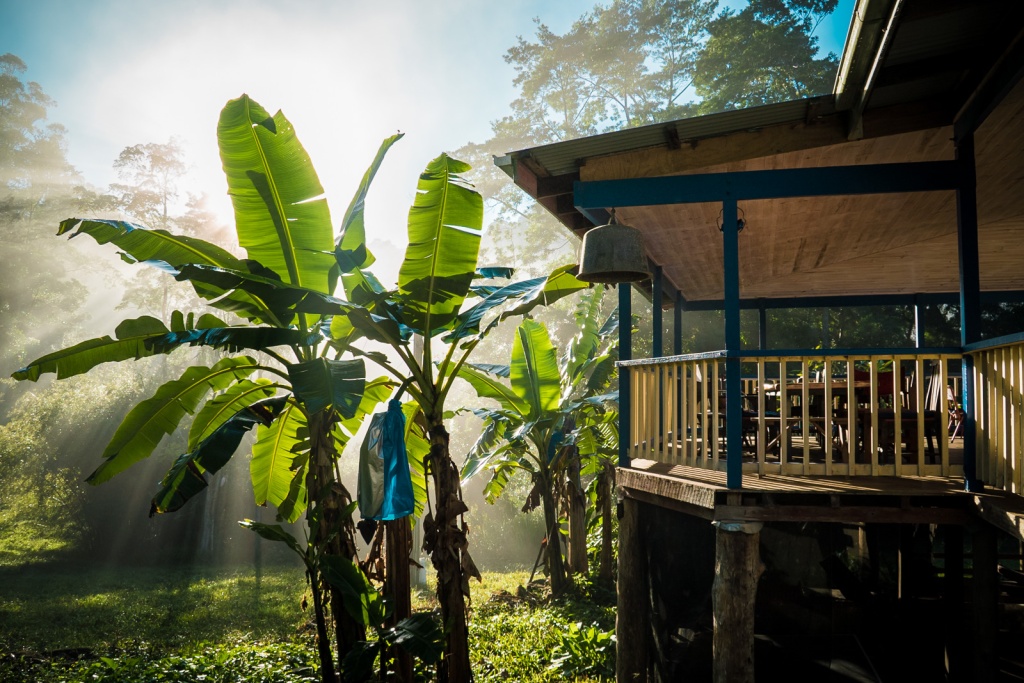
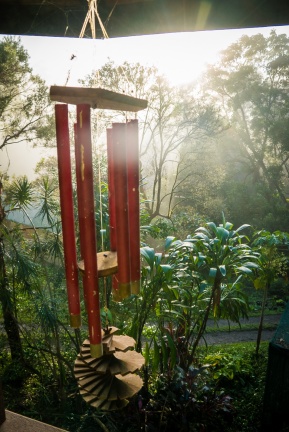 These communities are just foreign places where a different breed of people live, and I think of the inhabitants as “the lucky few” who are able to get away with this lifestyle while the rest of us muck about in uncreative suburbs and traffic congestion.
These communities are just foreign places where a different breed of people live, and I think of the inhabitants as “the lucky few” who are able to get away with this lifestyle while the rest of us muck about in uncreative suburbs and traffic congestion.

 About 20 minutes drive south of Coffs Harbour and close to the eclectic town of Bellingen which is back-dropped by a stunning Dorrigo National Park, this sub-tropical zone is our first real taste of the more northerly climes of Australia – wetter, more humid, more lush. It is an excellent climate for organic farming, straddling Mediterranean and tropical, and features lush rainforest, picturesque mountains, achingly-beautiful surf beaches and small, inviting towns. Heidi and I felt a lot of external loves and soul-filling elements clicking together here right off the bat.
About 20 minutes drive south of Coffs Harbour and close to the eclectic town of Bellingen which is back-dropped by a stunning Dorrigo National Park, this sub-tropical zone is our first real taste of the more northerly climes of Australia – wetter, more humid, more lush. It is an excellent climate for organic farming, straddling Mediterranean and tropical, and features lush rainforest, picturesque mountains, achingly-beautiful surf beaches and small, inviting towns. Heidi and I felt a lot of external loves and soul-filling elements clicking together here right off the bat. This community began in an appropriately activist manner: in the late 70’s, happy hippie folk used the farm land for environmentally joyful pursuits and were friendly with the local farmer who owned it. In 1981, the property came available for sale and Japanese interests swooped in with designs on redeveloping the land into a resort and golf course. The farmer sided with the concerned hippies and chose to sell the land to them which the group managed to do via their “alternative networks”. Hooray! This wily rogue of determined environmentalists defeated the big developers and have since cared very well for the land, even
This community began in an appropriately activist manner: in the late 70’s, happy hippie folk used the farm land for environmentally joyful pursuits and were friendly with the local farmer who owned it. In 1981, the property came available for sale and Japanese interests swooped in with designs on redeveloping the land into a resort and golf course. The farmer sided with the concerned hippies and chose to sell the land to them which the group managed to do via their “alternative networks”. Hooray! This wily rogue of determined environmentalists defeated the big developers and have since cared very well for the land, even  having part of it deemed a protected national park (Bongil Bongil).
having part of it deemed a protected national park (Bongil Bongil).
 chain-link in public areas, speed and traffic signs and so on. In my opinion, this is still and has always been one of the defining factors of living in community: you live together, trust each other and provide safe, harmonious and attractive common spaces that generally don’t require division or external policing. Going back into these conformist settings once you’ve been in a community like this immediately makes me feel uncomfortable. Mainstream society is largely not natural.
chain-link in public areas, speed and traffic signs and so on. In my opinion, this is still and has always been one of the defining factors of living in community: you live together, trust each other and provide safe, harmonious and attractive common spaces that generally don’t require division or external policing. Going back into these conformist settings once you’ve been in a community like this immediately makes me feel uncomfortable. Mainstream society is largely not natural. Conflict resolution and internal politics are things that we have heard about in every community so it is clear to us that it a good system needs to be established early on. Members indicate that this didn’t really happen in Bundagen and this is their only real issue. Clearly they have made it work on some level to last this long, but the potential for fallout came into full illumination with a community member who was causing a rift between villages and individuals for many years. As good stewards of communal-living principles, the community-at-large have employed ongoing attempts at personal support over time, but sterner measures were being discussed. By all counts, this is unusual but it seems like something that has gone on far longer than is needed as the community didn’t have a comprehensive plan on to come down hard on frequent offenders. A further downside that we experienced was gossip, not just from this but from other things, which I suspect could cause other rifts if left unchecked.
Conflict resolution and internal politics are things that we have heard about in every community so it is clear to us that it a good system needs to be established early on. Members indicate that this didn’t really happen in Bundagen and this is their only real issue. Clearly they have made it work on some level to last this long, but the potential for fallout came into full illumination with a community member who was causing a rift between villages and individuals for many years. As good stewards of communal-living principles, the community-at-large have employed ongoing attempts at personal support over time, but sterner measures were being discussed. By all counts, this is unusual but it seems like something that has gone on far longer than is needed as the community didn’t have a comprehensive plan on to come down hard on frequent offenders. A further downside that we experienced was gossip, not just from this but from other things, which I suspect could cause other rifts if left unchecked. On the plus side, Bundagen is lush, natural and beautiful with countless birds, monitor lizards, possums and bush turkeys in your garden (and the occasional python living in your rafters!); easygoing smiling folks from different walks of life doing creative and inspirational things with their diverse dwellings, clothing and interests; music/sing-along nights, working bees, clothing-optional bathing at the beach (apparently in the early days, even member meetings were in the nude!), wild organic gardens behind many homes, yoga/meditation sessions run by members; and a relaxed way of organising, administering and “being”. The downside, comparatively, might be what Bruderhof excelled at: structure and order, balanced education, blended multi-generational groups onsite, community unity (with gossip largely “outlawed”) and a central drive (Jesus) that affected every person; all this the kind of stuff that won’t happen without some forethought. Now, I know Bundagen residents would probably argue that some of those things are exactly what they don’t want, and I would personally choose a more organic lifestyle over a heavily constructed one, but there are levels of structure that Bundagen might consider virtues to employ, especially in light of their self-assessment on conflict resolution. And that’s not to say that Bundagen was lacking in a spiritual core; I think most people there felt some affinity with the Spirit, the land or both, they simply didn’t all subscribe to the exact same programme.
On the plus side, Bundagen is lush, natural and beautiful with countless birds, monitor lizards, possums and bush turkeys in your garden (and the occasional python living in your rafters!); easygoing smiling folks from different walks of life doing creative and inspirational things with their diverse dwellings, clothing and interests; music/sing-along nights, working bees, clothing-optional bathing at the beach (apparently in the early days, even member meetings were in the nude!), wild organic gardens behind many homes, yoga/meditation sessions run by members; and a relaxed way of organising, administering and “being”. The downside, comparatively, might be what Bruderhof excelled at: structure and order, balanced education, blended multi-generational groups onsite, community unity (with gossip largely “outlawed”) and a central drive (Jesus) that affected every person; all this the kind of stuff that won’t happen without some forethought. Now, I know Bundagen residents would probably argue that some of those things are exactly what they don’t want, and I would personally choose a more organic lifestyle over a heavily constructed one, but there are levels of structure that Bundagen might consider virtues to employ, especially in light of their self-assessment on conflict resolution. And that’s not to say that Bundagen was lacking in a spiritual core; I think most people there felt some affinity with the Spirit, the land or both, they simply didn’t all subscribe to the exact same programme.

 Giri had us help with constructing an artistic stone wall and other manual labour, and Jo was interested in our skilled labour so we helped her with a logo and website for her business. We enjoyed their hand-crafted open-plan mud-brick home which really took advantage of the lush surrounds, and was only a 5 minute walk from the warm ocean where we often started or ended our day with a swim. The sense of peace and serenity that the location and lifestyle offered to the folks in Bananas village was quite memorable, and I could easily see why it would be enticing to live there for decades – despite the occasional conflict – as so many had done. Membership is closed at Bundagen as they are full, which also really says something about the place. Definitely a little slice of heaven!
Giri had us help with constructing an artistic stone wall and other manual labour, and Jo was interested in our skilled labour so we helped her with a logo and website for her business. We enjoyed their hand-crafted open-plan mud-brick home which really took advantage of the lush surrounds, and was only a 5 minute walk from the warm ocean where we often started or ended our day with a swim. The sense of peace and serenity that the location and lifestyle offered to the folks in Bananas village was quite memorable, and I could easily see why it would be enticing to live there for decades – despite the occasional conflict – as so many had done. Membership is closed at Bundagen as they are full, which also really says something about the place. Definitely a little slice of heaven!


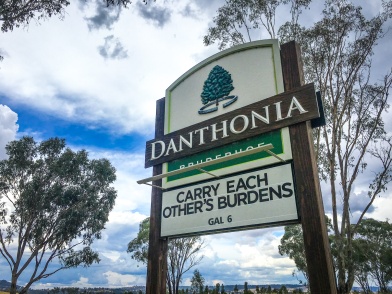
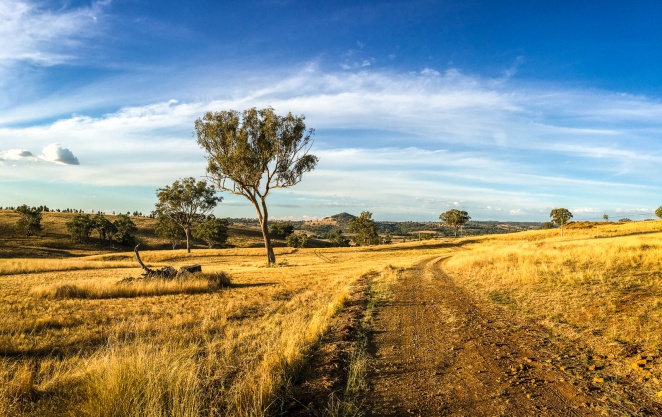
 In terms of “authentic community”, Bruderhof takes the
In terms of “authentic community”, Bruderhof takes the  All clothing is supplied as required and they have largely settled on a “uniform” of sorts: blue jeans and checkered shirts for men, somewhat formless Amish-style long dresses with head scarves for women. Rather than see these as sacrifices, Members embrace them as gifts: a way to keep them focused and pure; a way to keep life simple and sustainable; a way to dispense of the frivolities and unnecessary intrusions of modern life; and especially a way to keep their mind on the task of serving Jesus.
All clothing is supplied as required and they have largely settled on a “uniform” of sorts: blue jeans and checkered shirts for men, somewhat formless Amish-style long dresses with head scarves for women. Rather than see these as sacrifices, Members embrace them as gifts: a way to keep them focused and pure; a way to keep life simple and sustainable; a way to dispense of the frivolities and unnecessary intrusions of modern life; and especially a way to keep their mind on the task of serving Jesus.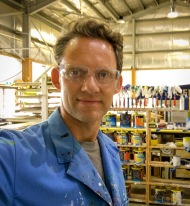
 I give full credit for the whole community making a valiant attempt to accommodate us with a vegetarian diet instead (sidebar story: there was a funny moment when a “Tyrolean folk song” about the harvest was sung that featured the lines: “If we raised nothing for people to eat // Then what would they live on if there were no meat? // No roast and no dumplings, for coffee and cream // No eggs and no chickens – Oh what a bad dream!” which had people around us giggling. Heidi and I sang the ending “oh what a good dream!” instead 😀 )
I give full credit for the whole community making a valiant attempt to accommodate us with a vegetarian diet instead (sidebar story: there was a funny moment when a “Tyrolean folk song” about the harvest was sung that featured the lines: “If we raised nothing for people to eat // Then what would they live on if there were no meat? // No roast and no dumplings, for coffee and cream // No eggs and no chickens – Oh what a bad dream!” which had people around us giggling. Heidi and I sang the ending “oh what a good dream!” instead 😀 )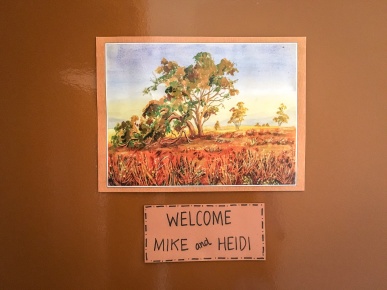 Most people that we met started their day before sun-up, so breakfast invitations were a constant source of struggle for me to be ready to talk at 6am. And this wasn’t idle chit-chat; in nearly every circumstance, some deep-down faith discussions were the topic on hand. As I mentioned above, this was something I wrestled with as my spirituality is a complicated mix of things that doesn’t fit neatly into a box. It might seem petty to mention given the extreme hospitality we experienced, but the only thing that bothered me was the level of evangelism that seemed to be happening in numerous visits. I fully understand that if you are committed to your faith and it is supposed to be a joyful centre of your existence then you want to share that, but I certainly felt like we were being challenged and preached to (and me, a little judged perhaps) at times.
Most people that we met started their day before sun-up, so breakfast invitations were a constant source of struggle for me to be ready to talk at 6am. And this wasn’t idle chit-chat; in nearly every circumstance, some deep-down faith discussions were the topic on hand. As I mentioned above, this was something I wrestled with as my spirituality is a complicated mix of things that doesn’t fit neatly into a box. It might seem petty to mention given the extreme hospitality we experienced, but the only thing that bothered me was the level of evangelism that seemed to be happening in numerous visits. I fully understand that if you are committed to your faith and it is supposed to be a joyful centre of your existence then you want to share that, but I certainly felt like we were being challenged and preached to (and me, a little judged perhaps) at times.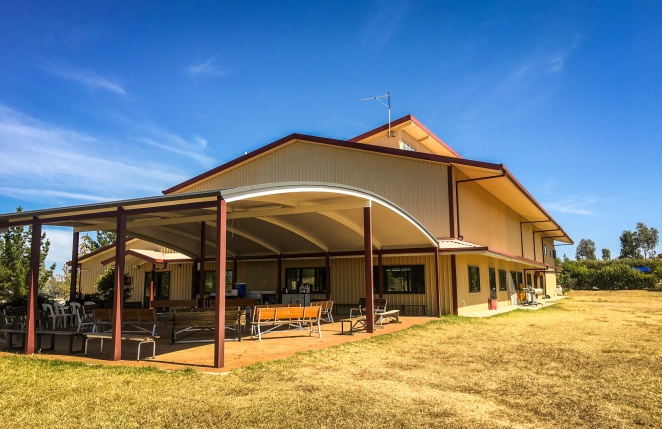
 This wasn’t just because we were new; I saw everyone doing the same
This wasn’t just because we were new; I saw everyone doing the same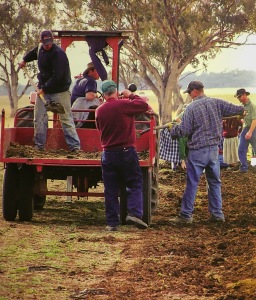 speaking of our hosts – Bill and Grace Anna – they were incredibly helpful, accommodating and forthcoming with their desire to make sure our stay went smoothly. Bill is soft-spoken with a wry sense of humour and gave us lots of reading material to take with us; Grace Anna was kind and fed us numerous times as well as provided guidance on campus. We are very thankful for both of them and the dozens of others we met and whom welcomed us in
speaking of our hosts – Bill and Grace Anna – they were incredibly helpful, accommodating and forthcoming with their desire to make sure our stay went smoothly. Bill is soft-spoken with a wry sense of humour and gave us lots of reading material to take with us; Grace Anna was kind and fed us numerous times as well as provided guidance on campus. We are very thankful for both of them and the dozens of others we met and whom welcomed us in








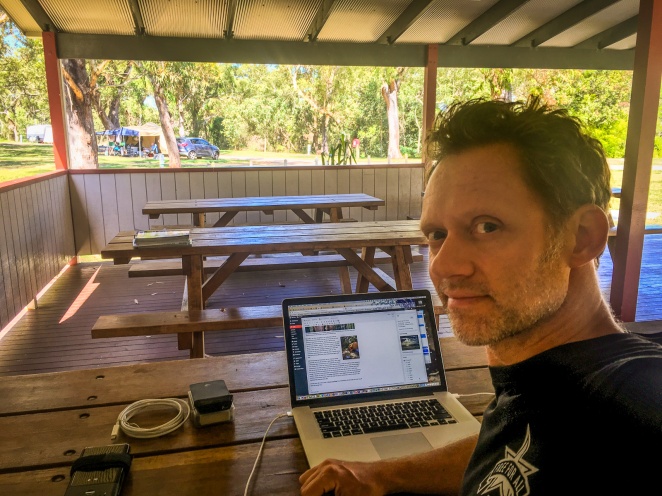

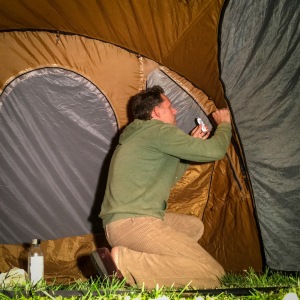 A few days before that, I indiscriminately grabbed boxes of camping gear from our long-term storage, and packed them into our car without even looking inside them to check everything was there. Thinking of this now confirms to me the somewhat blasé nature of this current expedition we are embarking on compared to the “fanfare” of last year’s first trip. That’s not to say I am treating this trip lightly, but perhaps I am approaching it with a bit more knowledge and confidence in this life direction we’re learning about.
A few days before that, I indiscriminately grabbed boxes of camping gear from our long-term storage, and packed them into our car without even looking inside them to check everything was there. Thinking of this now confirms to me the somewhat blasé nature of this current expedition we are embarking on compared to the “fanfare” of last year’s first trip. That’s not to say I am treating this trip lightly, but perhaps I am approaching it with a bit more knowledge and confidence in this life direction we’re learning about.

